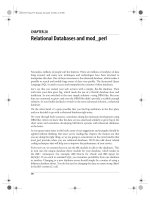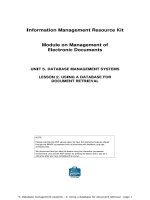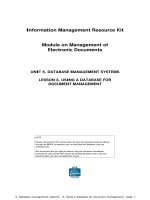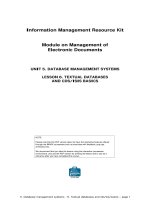UNIT 5. DATABASE MANAGEMENT SYSTEMS LESSON 5. RELATIONAL DATABASES AND SQL BASICSNOTE docx
Bạn đang xem bản rút gọn của tài liệu. Xem và tải ngay bản đầy đủ của tài liệu tại đây (530.04 KB, 18 trang )
5. Database management systems - 5. Relational databases and SQL basics – page 1
Information Management Resource Kit
Module on Management of
Electronic Documents
UNIT 5. DATABASE MANAGEMENT SYSTEMS
LESSON 5. RELATIONAL DATABASES
AND SQL BASICS
© FAO, 2003
NOTE
Please note that this PDF version does not have the interactive features offered
through the IMARK courseware such as exercises with feedback, pop-ups,
animations etc.
We recommend that you take the lesson using the interactive courseware
environment, and use the PDF version for printing the lesson and to use as a
reference after you have completed the course.
5. Database management systems - 5. Relational databases and SQL basics – page 2
Objectives
At the end of this lesson, you will be able to:
• understand the principles on which relational databases
and SQL are based.
• apply the Extended Entity Relationship (EER) model
to a simple set of data.
• understand the function of the main SQL statements.
Documents which allow you to create and modify relational
databases using SQL, are available for download and print
at the end of the lesson.
Introduction
How to build a relational
database?
The most popular kind of database is
the relational database, invented in
the 70s, where the data is stored as
relations.
The first step in building a relational
database is deciding how to organize
data, that is designing the database.
Then, the database can be created
and manipulated using the Structured
Query Language (SQL), which allows
interaction with relational databases.
5. Database management systems - 5. Relational databases and SQL basics – page 3
Relations can be viewed as two-dimensional tables where all the data is stored.
Let’s consider for example this Person table.
A row (or tuple) in a table is identified by a primary key. The other information in the row is
referred to as attributes.
Specifically, the ID column in this table is the primary key.
Table: PERSON
ID FirstName Lastname Work Phone
1001 Laura Williams 44.34.34.44
1002 Paul Smith 63.56.55.64
1003 David Fisher 21.86.77.24
Tuple
Attribute
Primary Key
Principles
Home Phone
45.34.34.45
63.35.13.44
21.79.33.99
EER Notation Name Description It may be
ENTITY
A class of real-world objects. It is
normally a noun. An Entity would
have one or many attributes.
physical object (e.g. person)
event (e.g. appointment)
concept (e.g. order).
descriptor (describe properties of the
entity, e.g. lastname of the person)
identifier (uniquely distinguish entity
instances - primary key in relational
context)
ATTRIBUTE A property of an entity
composite (a group of attributes
used as a single attribute)
RELATIONSHIP
Describes the relationship
between entities. Typically
expressed in verbs (e.g. has).
There are no well defined standards of
the EER notation.
EER modelling
The design phase must identify the relationships between entities that properly describe the
collection.
The Extended Entity Relationship (EER) model is one of the most widely used frameworks for
data modelling. It is based on three main categories:
5. Database management systems - 5. Relational databases and SQL basics – page 4
EER modelling
Let’s consider this example.
You have created a database for your video-rental
store.
Can you identify the following parts of the table?
Table: MOVIE
Code Title Director Year
100 Sophie’s
choice
Pakula 1982
101 The great
dictator
Chaplin 1940
102 Dracula Coppola 1992
102
Movie
Chaplin
Choose your answers
EER modelling
Now, let’s consider another
example.
We want to develop a very
simple appointment database for
a doctor’s office.
All we want to record are:
• patient details,
• doctor details, and
• appointments between the
doctor and patients.
Let’s look at the development
step by step.
5. Database management systems - 5. Relational databases and SQL basics – page 5
EER modelling
The first step in EER modelling is:
Identify entity sets and the
relationships between them.
We can immediately identify two
entities: Patient and Doctor.
A patient would have
appointments with one or more
doctors.
A doctor would have appointments
with zero or more patients.
EER modelling
The second step is:
Identify attributes of each entity set.
We will now add all the patient and doctor details that we need.
In this example we will omit some obvious attributes (such as address) in order to simplify the
model.
5. Database management systems - 5. Relational databases and SQL basics – page 6
EER modelling
The third step is:
Identify any attributes associated with relationships. If any exist, create relationship
sets.
The appointment would have a date, time and duration.
Appointment is a weak entity, that is its unique identifier is derived from some ‘parent’ entity
(e.g. patient) and it will cease to exist if its parent is removed. In this case, if the patient is
removed so is the patient’s appointment.
EER modelling
The fourth step is:
Identify overlapping attributes.
These are the attributes that are
repeated and therefore cause
redundancy.
In your opinion, which of the following attributes are overlapping?
Name
Date
Date registered
Phone
Click on your answers
5. Database management systems - 5. Relational databases and SQL basics – page 7
EER modelling
We can see that patient and doctor have a lot of similar attributes (name, phone, etc ). We could
also have the case that most doctors also are patients from time to time. For these reasons, we
will add an overlapping generalization hierarchy to our model by adding a Person entity.
EER modelling
The fifth step is:
Select identifiers for each entity set.
None of the existing attributes for Person, Patient and Doctor can ensure that an instance would
be unique. We will therefore need to include id attributes. Appointment is a relationship set, so
it is not strictly necessary to define a key at this stage; although it will probably have a composite
key made up of the patient id, date and time.
5. Database management systems - 5. Relational databases and SQL basics – page 8
Normalization
5. Repeat steps 1-4 for every relation.
More information about normalization
Normalization is an alternative formal technique for defining relations that contain minimum
redundancy.
It is a bottom-up design technique, which makes it difficult to use in large designs.
For this reason it has been largely superseded by the top-down approaches (e.g. EER), but it can
be used as another method of checking the properties of a design arrived at through EER
modelling. This can be done as follows:
1. Identify the key (simple or composite) of each relation.
2. Identify any foreign keys in a relation.
3. Check that the other attributes in the relation are
determined by the relation’s key.
4. Create a new relation comprising any attributes not
determined by the relation’s key.
For example, consider the relation on the left.
PatientID is the primary key and RegisteredWith is
the foreign key which refers to the primary key of the
Doctor relation (i.e. DoctorID
).
The value in the foreign key can refer to only one
tuple in the DOCTOR relation, although the DoctorID
can be referenced by many foreign key values. That
is, a patient instance can only be registered with one
doctor, but many patients can be registered with the
same doctor.
Patient(PatientID, Name,
RegisteredWith)
Doctor(DoctorID
, Name,
RoomNo)
Mapping a logical model to a relational schema
Based on our EER model, we have to design the relational schema.
In other words, we have to express the relationships between relations. To do this we use
foreign keys.
A foreign key is an attribute in one relation that refers to the primary key in a related relation.
5. Database management systems - 5. Relational databases and SQL basics – page 9
The PersonID, PatientID and DoctorID
attributes act both as primary keys within their
own relation, and as foreign keys to the
matching rows in the other two relations.
PERSON(PersonID, FirstName,
LastName, HomePhone, WorkPhone)
How to express relationships in our schema? We will use three separate relations for
Person, Patient and Doctor.
The relationship between Appointment and both
Patient and Doctor is implemented using foreign
keys (PatientID and DoctorID).
As primary key for Appointment, we choose the
composite key “PatientID, Date, Time” allow for an
appointment between one or many patients and
one doctor.
APPOINTMENT(PatientID, DoctorID,
Date
, Time, Duration)
Comparison between the possible methods
Mapping a logical model to a relational schema
Note that we choose to use this method
because of the the complexity of a person
being both a doctor and a patient. Other
methods are available:
DOCTOR(DoctorID, RoomNo)
PATIENT(PatientID, DateRegistered)
From relations to tables
The relational schema is now defined.
We have designed our database: next
step is to create it.
Based on our design, we can now create, manipulate
and control our database.
Specifically, we have to:
• build the database structure (e.g. create tables and
relations between them);
• add, delete, and modify data in the tables; and
• control what users may or may not do with the
objects in the database.
To do this we need to use the Structured Query
Language (SQL).
5. Database management systems - 5. Relational databases and SQL basics – page 10
From relations to tables
SQL is the language used to interact with a relational database.
SQL is more than simply a query language; it is a database sub-language and is becoming the
standard interface to relational and non-relational database management systems (DBMS).
The DBMS stores the data and retrieves or updates it in response to SQL statements.
SQL was originally designed as a query language based on the relational algebra. It started as a
language called Sequel (Structured English QUEry Language) which was developed by IBM in the
mid-1970s as the data manipulation language (DML) of one of their early attempts at a relational
database.
This language allowed users to access and manipulate data stored in the database. During the
early 1980s, IBM renamed the language SQL and based two of their relational database packages,
SQL/DS and DB2, on this language.
SQL was adopted as an industry standard in 1986 (SQL-86). Since then there has been three
more standards, SQL-89, SQL2 (or SQL-92) and SQL3 (or SQL-99).
All commercial relational database vendors now support some variant of the SQL standard. It is
also the basis of most database interoperability products and proposals (e.g. ODBC).
You can find information about SQL validators at: />Parts of SQL
CREATE TABLE person (
personid INTEGER NOT NULL,
firstname VARCHAR(20) NOT NULL,
lastname VARCHAR(20) NOT NULL,
homephone CHAR(12),
workphone CHAR(12),
PRIMARY KEY (personid)
);
The Person relation can be translated into a
SQL table using the CREATE TABLE
statement.
As you can see in the example, the person
identifier is an integer.
For first and last name, VARCHAR means that
data values are expected to vary considerably
in size, up to 20 (data length in bytes).
Home and work phone data values (CHAR) are
expected to be consistently close to the same
size (12), and they may be not present in the
table.
The PersonId attribute is finally specified as
primary key.
PERSON(PersonID, FirstName, LastName,
HomePhone, WorkPhone)
5. Database management systems - 5. Relational databases and SQL basics – page 11
Parts of SQL
CREATE TABLE patient (
patientid INTEGER NOT NULL,
regdate DATE NOT NULL,
PRIMARY KEY (patientid),
FOREIGN KEY (patientid) REFERENCES person
(personid)
ON DELETE CASCADE
ON UPDATE CASCADE
);
Now let’s consider the Patient relation.
Note that the PatientID attribute acts both as
primary key and as foreign key in relation with
the Person entity.
The “ references” clause is used to specify
referential integrity constraints and, optionally,
the actions to be taken if the related row is
deleted (ON DELETE) or the value of its
primary key is updated (ON UPDATE).
CASCADE means that:
• on update, a change to the primary key value
in the related row is reflected in the foreign
key;
• on delete, if the related row is deleted then
so is the row containing the foreign key.
PATIENT(PatientID, DateRegistered)
Parts of SQL
CREATE TABLE doctor (
doctorid INTEGER NOT NULL,
roomno CHAR(4),
PRIMARY KEY (doctorid),
FOREIGN KEY (doctorid) REFERENCES person
(personid)
ON DELETE CASCADE
ON UPDATE CASCADE
);
DOCTOR(DoctorID, RoomNo)
Our third relation is the Doctor
relation.
Could you complete the creation of the
Doctor Table?
Complete the SQL by typing the correct
characters in the empty fields. Then
click on the "check answer" button.
Check answer
5. Database management systems - 5. Relational databases and SQL basics – page 12
Parts of SQL
CREATE TABLE appointment (
patientid INTEGER NOT NULL,
doctorid INTEGER,
appdate DATE NOT NULL,
apptime TIME NOT NULL,
duration INTEGER DEFAULT 15,
PRIMARY KEY (patientid, appdate, apptime),
FOREIGN KEY (patientid) REFERENCES person
(personid)
ON DELETE CASCADE
ON UPDATE NO ACTION,
FOREIGN KEY (doctorid) REFERENCES person
(personid)
ON DELETE SET NULL
ON UPDATE CASCADE
);
PatientId/PersonId
If the related Person row is deleted then so is
the row containing PatientId, therefore the
appointment is deleted.
If the PersonId value is updated nothing
happens to the PatientId in this table (this
means that the foreign key is here just a
reference).
DoctorId/PersonId
If the related Person row is deleted then the
DoctorId value is set to null, but the
appointment is not deleted.
If the PersonId value is updated then the
change is reflected in the DoctorId.
APPOINTMENT(PatientID, DoctorID, Date,
Time
, Duration)
Finally, let’s have a look at the appointment relation.
Note that appointment has three primary keys: PatientId, Date and Time.
Parts of SQL
The DROP statement is used to remove a table.
CASCADE drops all associated referential
integrity constraints and views that depend on
this base table, whereas RESTRICT raises an
exception if any of these exist.
mysql> DROP TABLE person RESTRICT;
mysql> DROP TABLE person CASCADE;
The Create table statement we have seen belong to the Data Definition Language (DDL), a
part of SQL’s statements.
DDL comprises all the statements used to define the data structures such as creating,
altering and deleting schemas and tables, etc.
The most important statements are CREATE, DROP and ALTER.
The ALTER statement is used to add or delete a
column in a table.
As above, CASCADE and RESTRICT determine
the drop behaviour when constraints or views
depend on the affected column.
mysql> ALTER TABLE person ADD COLUMN
address;
mysql> ALTER TABLE person DROP
COLUMN address RESTRICT;
mysql> ALTER TABLE person DROP
COLUMN address CASCADE;
5. Database management systems - 5. Relational databases and SQL basics – page 13
Parts of SQL
Having created a structure for the tables in your database, you may want to add, delete, retrieve
or modify data in the tables. This is done by using the SQL data manipulation statements.
This part of SQL is named the Data Manipulation Language (DML).
Following are the DML essential statements:
Used to retrieve information from tables.
SELECT
INSERT
UPDATE
DELETE
Used to add a new row or a set of rows.
Used to modify an existing row.
Used to remove rows.
Parts of SQL
This set of statements is called the Data
Control Language.
The primary mechanism for enforcing
control issues in SQL is through the
concept of a view.
Views are virtual tables which act as
‘windows’ on the database of real tables.
Access can be restricted on tables and
views to particular users via the GRANT
and REVOKE facilities of SQL.
There is another part of SQL that allows the control of what users may or may not do with
the objects in the database.
5. Database management systems - 5. Relational databases and SQL basics – page 14
Using SQL- tools
The following document describes the procedures to create a database, and how to manipulate
tables and data using SQL:
Note: unless otherwise
stated, all examples are in
compliance with the SQL2
standard.
You can also view only the sections you are interested in:
Creating a database
Creating a new database
Creating and Listing Tables and Fields
Data types on various database platforms
Creating SQL tables
Table Manipulations
Inserting data
Adding new rows
Modifying existing rows
Removing rows
Selecting data
The SELECT statement
Joining tables
UNION, EXCEPT and INTERSECT operators
These documents
describe procedures
using MySQL Windows
version 3.23. Click on
the link to learn more
about MySQL.
MySQL Database Server
The MySQL database server is the world's most popular open source database. The MySQL Database Server can be
obtained from the MySQL download portal at:
MySQL is available at zero price under the GNU General Public License (GPL), and is also sold under a commercial
license to those who do not wish to be bound by the terms of the GPL. To learn more about the MySQL(TM) database
server and other MySQL products visit: To learn more about the
MySQL Licensing Policy please visit: />An HTML version of the MySQL Reference Manual can be found and searched at:
/>. It is also available many other formats, including PDF and Windows HLP
versions at: />Because all MySQL products are open source, free support provided by the MySQL community is available on the
MySQL public mailing lists. You can subscribe to the MySQL mailinglist(s) using the MySQL Mailing Lists Subscription
Tool available at: />MySQL AB also publishes a monthly email newsletter with articles about new products, new features, training, security
issues, known bugs, and events of interest to the MySQL community. You can subscribe to the newsletter by using the
online subscription form or by sending email to with 'subscribe' in the subject line.
Using SQL- tools
5. Database management systems - 5. Relational databases and SQL basics – page 15
Summary
• SQL (Structured Query Language) is the language used to interact
with a relational database.
• Relational databases, and the SQL standard, are based on a relational
model, which derives from the concept of relation.
• Database design is fundamentally a task in data modelling; the
Extended Entity Relationship (EER) model is one of the most widely
used frameworks for data modelling.
• We can use the normalization technique to check the properties of
our design.
• SQL statements are grouped into three main parts: Data Definition
Language (DDL), Data Manipulation Language (DML), Data Control
Language (DCL).
Exercises
The following five exercises will allow you to apply the principles of data modelling for a relational
database.
Good luck!
5. Database management systems - 5. Relational databases and SQL basics – page 16
Exercise 1
Let’s consider again the example of the video rental store.
In this case, you would create a database to register the actors and
directors of the movies available.
All you want to record are:
• actor details,
• director details, and
• collaboration between actors and directors.
The first step in EER modelling is to identify entity sets and the relationships between them.
Can you do it?
Type the text in the relevant boxes. Then, click on Check answer.
(0,n) (0, n)
Exercise 2
Second, you have to identify the attributes of each entity set.
You want to record the details listed here below. Can you add them to the diagram?
Select each option and drag it in the relevant fields.
actor
collaboration
director
(0,n) (0, n)
Nationality
First
Style
First
Last
Name
Age
Nationality Name
5. Database management systems - 5. Relational databases and SQL basics – page 17
Exercise 3
Type your text in the relevant box.
collaboration
(0,n)
(0, n)
has
Movie
The composite attribute “movie” is associated to the relationship “collaboration”.
Could you identify the overlapping attributes?
First
Last
Name
Nationality
Age
actor
director
Nationality
First
Last
Name
Style
Title Year
has
Exercise 4
Type your text in the relevant box.
Which general entity would you add to the model?
collaboration
(0,n)
(0, n)
Movie
Age
actor
director
Style
Title Year
has
has
5. Database management systems - 5. Relational databases and SQL basics – page 18
Exercise 5
To create and manipulate your database it is important to know the main SQL statements.
Could you group them into the SQL categories?
Data Definition Language (DDL)
Data Manipulation Language (DML)
Data Control Language (DCL)
CREATE, DROP, ALTER
SELECT, INSERT, UPDATE, DELETE
GRANT, REVOKE
a
1
Standard message (drag and drop)
If you want to know more
C.J. Date. An Introduction to Database Systems Addison Wesley; ISBN:
0201787229. The definitive book on database systems.
C.J. Date, Hugh Darwen. Foundation for Future Database Systems: The Third
Manifesto Addison Wesley; ISBN: 0201709287.
Jim Melton, Alan Simon. SQL 1999: Understanding Relational Language Components.
Morgan Kaufmann; ISBN: 1558604561
Joe Celko (Foreword), Michael J. Hernandez, John L. Viescas. SQL Queries for Mere
Mortals: A Hands-on Guide to Data Manipulation in SQL. Addison Wesley; ISBN:
0201433362
SQL.ORG. Guide to online SQL resources. www.sql.org/online_resources.html
Intelligent Enterprise: A magazine dedicated to strategic business applications that
turn information into intelligence. (www.intelligententerprise.com)
SQL Validation and resources from Mimer SQL.
/>The MySQL Database Server and MySQL Reference Manual can be obtained from the
MySQL download portal at: along with other MySQL products.









